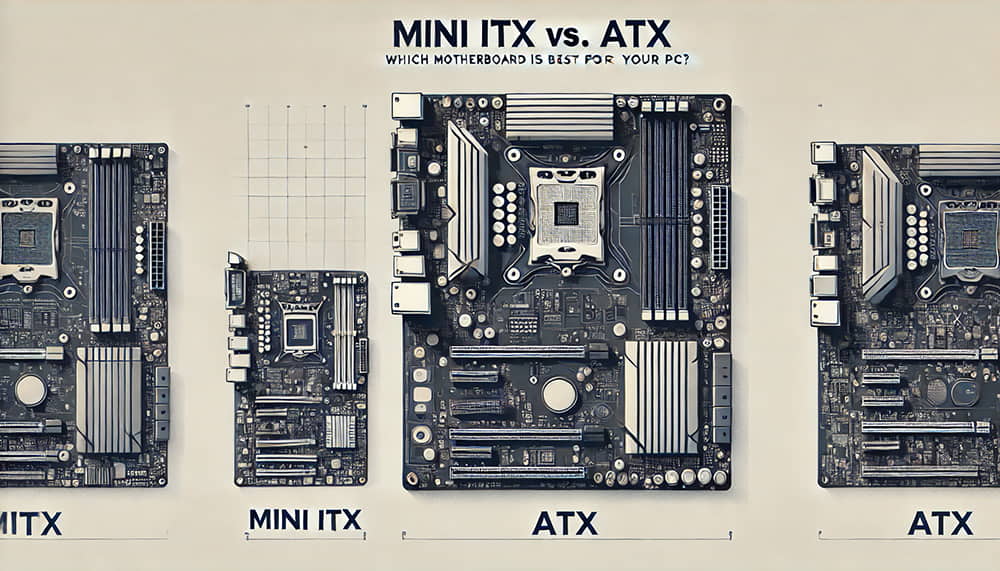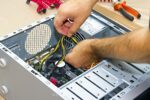Choosing the right motherboard is crucial when building a PC, as it determines both the expandability and overall performance of the computer. Mini ITX and ATX motherboards represent two extremes in terms of size and functionality, so knowing their differences will help you select the best option for your needs. In this guide, we show you a detailed comparison between Mini ITX and ATX so you can choose the perfect motherboard for your next PC project.
You can see all the available motherboards on our website.
Differences between Mini ITX and ATX
The main differences between Mini ITX and ATX motherboards focus on size, component compatibility, and expandability. These features will largely determine the performance and versatility of your computer.
Size and Compatibility
- Mini ITX: At 170 x 170 mm, Mini ITX boards are compact and designed for small cases. This space limitation reduces the number of components that can be installed, but allows for the creation of very compact PCs that take up less space.
- ATX: ATX boards measure approximately 305 x 244 mm and are compatible with standard-sized and larger cases. This form factor supports a larger number of ports and slots, making it the best choice for high-performance systems and users who plan to add additional components.
Expandability
- Mini ITX: Expansion capability is limited on Mini ITX boards, as they typically only feature one PCIe slot for a graphics card and a reduced number of SATA ports and RAM slots (usually two). This limits upgrade possibilities, but is ideal for users looking for a compact, basic configuration.
- ATX: In comparison, ATX boards offer multiple PCIe slots and additional ports, allowing for the installation of dual graphics cards, sound cards, and other components. Most ATX boards also include four RAM slots, allowing for increased memory capacity for intensive tasks.
Advantages of a Mini ITX Motherboard
Mini ITX boards are designed to meet small space requirements without compromising on a computer’s basic functionality. Below, we explore their key advantages.
Ideal for Compact PCs
Mini ITX is the ideal choice for those looking for a compact PC that can fit into small spaces. This type of board is common in HTPC (Home Theater PC) and mini desktop PC setups that offer decent performance in a small form factor. Thanks to their size, Mini ITX boards allow for greater portability, and are ideal for those who want a small, discreet computer.
Reduced Power Consumption
With fewer components and fewer expansion slots, Mini ITX boards typically consume less power. This efficiency makes them a good choice for users looking to reduce power consumption and decrease heat generation in their equipment, which is beneficial for both the system and the environment.
Advantages of an ATX Motherboard
On the other hand, ATX motherboards are designed for those looking for maximum functionality and expansion possibilities in their equipment.
Greater Number of Ports and Slots
One of the main advantages of an ATX motherboard is its ability to support a wide range of components. This includes multiple PCIe slots, several additional SATA and USB ports, and slots to install up to four RAM modules. These features are ideal for those who need a versatile system with the possibility of future expansion, such as adding network or sound cards.
Better Performance for Advanced Tasks
ATX motherboards offer better performance for intensive tasks, such as high-demand gaming, video editing, graphic design, or advanced programming. By supporting more RAM modules and dual or triple GPU configurations, ATX motherboards are the best choice for gaming enthusiasts, multimedia editing professionals, and advanced users looking for maximum performance.
Conclusion: Which Motherboard Format is Best for You?
Choosing between a Mini ITX or ATX motherboard will depend primarily on the type of use you want to give your PC and the space available for your computer. If you are looking for a compact, energy-efficient computer with no future expansion plans, a Mini ITX is ideal. However, if you want a computer that allows for multiple components and offers you greater performance, the ATX motherboard is the most versatile option and is prepared to support advanced tasks.







